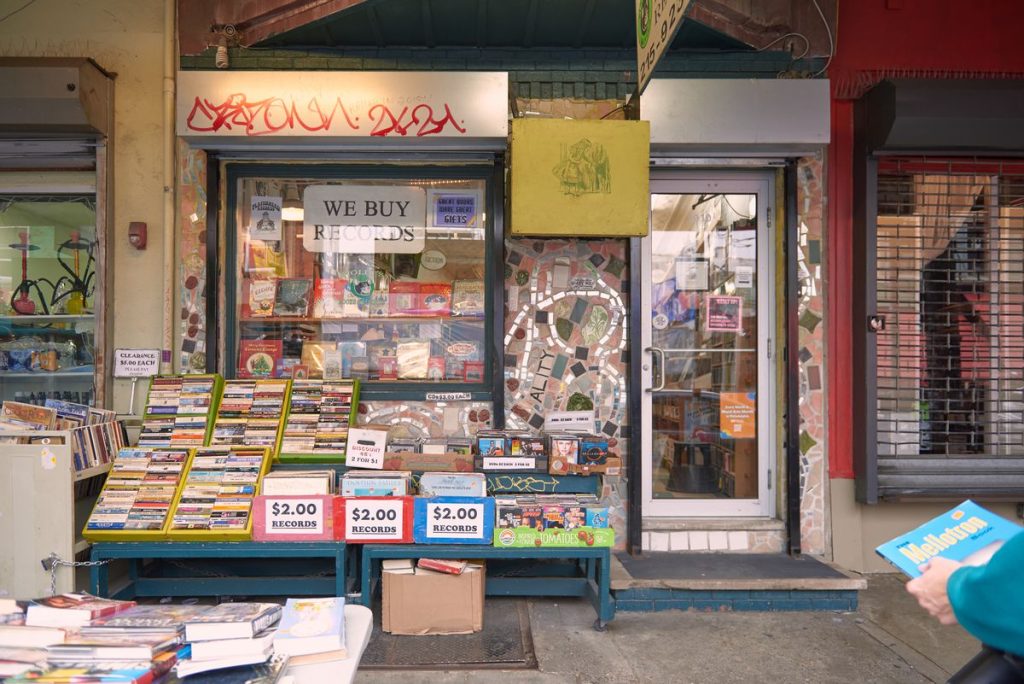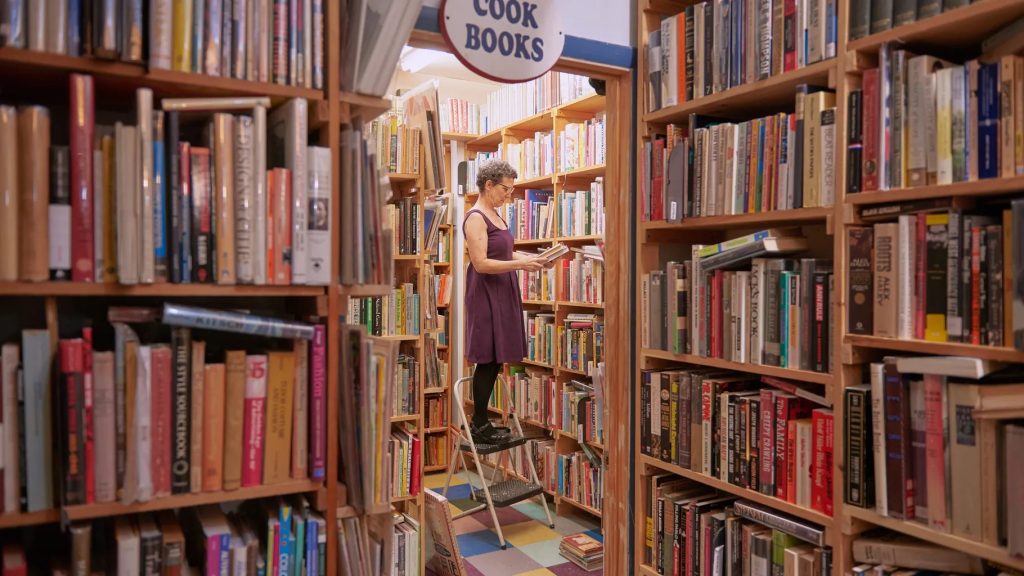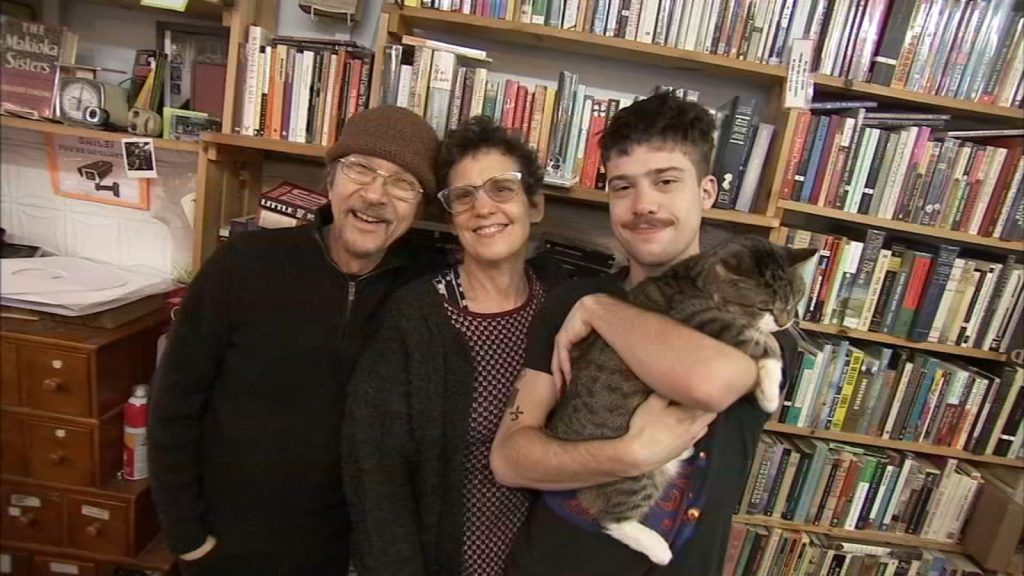
The “Lived-in” Vibe of Molly’s Books & Records
Molly’s Books & Records invites customers to discover a combination of personal and public interests that create the spatial narrative of a home. Outside of the shop, there are tables of assorted books and cheap records. The tables create somewhat of a tunnel that surrounds passersby, acting as a kind of bookish “landscaping”. Molly’s is situated in Philly’s Italian Market, and the tables outside closely resemble the food stalls of the vendors in the neighborhood.
The inside of the 600-square-foot store is split into three general sections. The first section is the busiest and functions most like a family/living room, the hub of all household activity. When you walk in, the rightmost wall has a small section for CDs, DVDs, and VHS tapes. Past that are more records and a small poetry section. These three areas lead up to the Ankebrands’ apartment door. On your left is the sales counter, and past that a long wall of fiction. These areas all form the walls of a rectangle with the main record area right in its middle. The sales counter closes off the left side of the store from those coming in, directing the traffic flow in a counterclockwise loop. There is a small rare/valuable books section behind the counter, a way of keeping precious items near a kind of ‘home base’.

The second section of Molly’s begins with two categories: Local and Philosophy/Religion. This section forms a rectangular alcove that has nonfiction books to the right and art to the left. The “Local” section reflects a piece of the community that Molly’s is a part of, acknowledging its place in a neighborhood with various interests. The Philosophy/Religion section also reflects the diverse audience that the family invites into their ‘home’.
The final section is another alcove that Molly deems the “Cookbook Room”. It is interesting that Molly herself refers to this section as a room since the store has an open layout. This implies that she sees the shop as a kind of living space as well, with different ‘rooms’ of different subjects. The cookbook room acts as a kind of separate zone from the rest of the store as it is the only space dedicated to one subject category. This section is a defining feature of Molly’s Books & Records. As the final destination in the store, it is a focal point, placed at the back so customers walk through the entire store to reach it.
Click here to view the accessible version of this interactive content
Molly places emphasis on organization, maneuverability, and cleanliness in her shop. These qualities are similar to those people try to create in their homes. Because of the open layout, customers do not have a choice of where to walk, increasing the feeling that they are entering a space that is not entirely subject to their whims. Molly acknowledges her desire to make the shop feel like coming into a home. She achieves this vibe with the simple layout of the store, easy to navigate but also slightly cluttered, giving a ‘lived-in’ kind of feeling. The books are arranged in alphabetical order to help customers browse, but the shelves are cluttered. Molly said this organization has been pretty consistent over time. This hearkens back to the idea of an inhabited space rather than a commercial business, since people do not constantly change their living spaces.
The lighting of the store is fluorescent, an economic choice Molly made for her business (“It needs to be bright”). She stresses the idea of having a “welcoming and friendly” attitude toward customers. In this way, the family does cater to their ‘guests’. They try to stock books that are popular with their audience even if they are not personal favorites. This is reminiscent of a host’s duty to accommodate the guests who visit their house. In fact, Molly stated that they used to hold events in the store, such as weekly poetry readings. This shows the purpose of the shop’s open layout, which is meant to act as a communal space for people to gather rather than a private one.

Molly has a clear vision of what she wants her store’s narrative to be. She has made personal choices not to sell books online as it takes them away from the shelves and overcomplicates the selling process. Online bookselling does not align with the “what you see is what you get” transparency of the home environment she has created, so they did not continue to do it. The shop also used to accept donations, but received too many items that “didn’t belong on the shelves”. Molly’s is a public shop that sells personally curated used goods. They want to communicate this feeling of personal touch and interest through their store’s inventory. The lights and bookshelves vary across the shop, again communicating an organic feel. The bookshelves themselves appear to be made of a raw material that contrasts the smooth, polished look of chain bookstores.
There are various non-book items throughout the store. Molly sells store merchandise such as mugs and t-shirts, which are placed near/behind the sales counter. She also draws notecards with illustrations from old children’s books that appear to be displayed near the sales counter as well. Molly handpainted all of the signs that hang from the ceiling notifying customers where each section is. The shop even has a pet cat, Mrs. Stevenson, another addition that makes Molly’s feel like a regular homestead.
In fact, the shop seems to have parts that belong to each family member. Upon entering the store, the CDs, records, and poetry straight ahead represent Johnny, Joe, and Molly. Going straight back, customers next come across the local section, which metaphorically represents the Italian Market community. The other literature sections reflect different facets of personal life: religion, philosophy, fiction, nonfiction, and the arts. These things can all hold stories, memories, and meanings, just like a personal library.

The main spatial narrative that all of these elements project is that of a community/home that emphasizes literature as a shared experience. You are reminded of this through the cookbook room in the back of the store, which acts as a reminder of and homage to the location of the store. The door to the family’s apartment reminds you how the owners are directly connected to the store and subsequently the surrounding community. Rather than a commercial space, they wish to tell the story of a communal ‘home’. Molly’s merchandise allows customers to become even more a part of this ‘home’. Also, the simple fact that the shop only carries used products suggests a narrative of the arts as a shared activity. There is a place for each family member, but also one for each customer.
Through this narrative with their shelves and items, Molly’s Books & Records “…speaks to its own cultural context” (Pyne). The bookstore merges the unique surrounding area of the Italian Market with the family members’ personal focuses, using community serving as the bridge between them. Pyne also asserts that bookshelves “…radiate personal identity and institutional purpose” (Pyne). This is particularly true in the case of Molly’s: the family has continued to find harmony between reflecting their own tastes and styles in their store and also appealing to those ‘guests’ that frequent it. At the end of the day, Molly’s is still a business and has to make some compromises for the sake of sustainability. However, the shop’s narrative has allowed it to function as more than just a space to purchase items, but a comfortable place to create a personal and public conversation around them.
Images
B., Patrick. Yelp, 9 Mar. 2019, https://www.yelp.com/biz_photos/mollys-books-and-records-philadelphia?select=D-jiokMHHKwAYQDjXvGa7g. Accessed 1 Nov. 2023.
C., Bri. Yelp, 31 July 2022, https://www.yelp.com/biz_photos/mollys-books-and-records-philadelphia?select=_hDaBMI9RDKwfe0JXcbr9A. Accessed 1 Nov. 2023.
C., Bridget. Yelp, 9 Jul. 2016, https://www.yelp.com/biz_photos/mollys-books-and-records-philadelphia?select=D-jiokMHHKwAYQDjXvGa7g. Accessed 1 Nov. 2023.
C., C. Google Reviews, 2023. Accessed 1 Nov. 2023.
C., Marietta. Yelp, 9 Dec. 2018, https://www.yelp.com/biz_photos/mollys-books-and-records-philadelphia?select=D-jiokMHHKwAYQDjXvGa7g. Accessed 1 Nov. 2023.
C., Marietta. Yelp, 9 Dec. 2018, https://www.yelp.com/biz_photos/mollys-books-and-records-philadelphia?select=D-jiokMHHKwAYQDjXvGa7g. Accessed 1 Nov. 2023.
Fletcher, MJ. Google Reviews, 2022. Accessed 1 Nov. 2023.
Henninger, Mark. Google Reviews, 2018. Accessed 1 Nov. 2023.
Molly’s Books & Records Family: “Married Couple Shares Their Love of Books, Music at Molly’s Books and Records in South Philly.” 6abc Philadelphia, 3 Mar. 2022, 6abc.com/mollys-books-and-records-italian-market-south-philadelphia-art-of-aging/11617396/.
Nova, Super. Google Reviews, 2022. Accessed 1 Nov. 2023.
Piserchio, Natalie. Eater Philadelphia, 13 Dec. 2021, https://philly.eater.com/2021/12/13/22820597/mollys-books-records-italian-market-bookstore-cookbooks. Accessed 1 Nov. 2023.
Shifman, Jay. Google Reviews, 2023. Accessed 1 Nov. 2023.
Soifer, Alejandro. Google Reviews, 2016. Accessed 1 Nov. 2023.
Williams, Eric. Google Reviews, 2016. Accessed 1 Nov. 2023.
Other Citations
Floor Plan, courtesy of Molly Russakoff.
Pyne, Lydia. Bookshelf. Bloomsbury, 2016.
Russakoff, Molly. Video conference interview. Conducted by Lexie Kauffman et al., 28 Oct. 2023.
Thinglink. “Create Unique Experiences With Interactive Images, Videos & 360 Media.” ThingLink, www.thinglink.com/. Accessed 1 Nov. 2023.

0 Comments